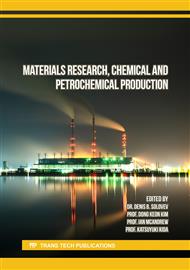p.3
p.11
p.19
p.27
p.35
p.41
p.49
p.59
Acid-Activated Organobentonite-Based Highly Porous Foams via Polymerized High Internal Phase Emulsion: Preparation, Characterization and Machine Learning Prediction
Abstract:
Preparation, characterization, and machine learning prediction of characteristics of acid-treated organobentonite-based highly porous foams via polymerized high internal phase emulsion were reported in this work. The effect of acid-treated organobentonite (AC-BTN) as an inorganic filler on the properties of poly(DVB)HIPE porous foam was experimentally investigated. Incorporating AC-BTN into the continuous phase of the high internal phase emulsion would improve thermal and mechanical properties and also increase the surface area of the resulting materials when compared to the unfilled poly(DVB)HIPE foam. Various amounts of AC-BTN, i.e., 0, 1, 3, 5, 7, and 10 wt.% of AC-BTN, were incorporated into the continuous phase to enhance the properties of poly(DVB)HIPE foam. The surface area and the degradation temperatures (Td) for the series of poly(DVB)HIPE foam filled with AC-BTN increased with increasing filler content from 0 to 10 wt.%. The maximum improvement of mechanical properties was found with the addition of 5 wt.% of AC-BTN into the continuous phase of poly(DVB)HIPE foam. Moreover, the adsorption of CO2 gas by poly(DVB)HIPE foam filled with AC-BTN was found to increase as well. It has been demonstrated in this study that the adsorption of CO2 by poly(DVB)HIPE foam filled with AC-BTN increased by 127% (from 0.00295 to 0.00670 mol/g) compared with neat poly(DVB)HIPE foam. Additionally, the machine learning (ML) method with a linear regression algorithm was employed for the characterization of poly(DVB)HIPE foam and the prediction of properties according to composite composition. Surface area, pore volume, Td, compressive stress, and Young’s modulus were evaluated. The accuracy of prediction using a machine learning application with a linear regression model for properties of poly(DVB)HIPE foam filled with AC-BTN was also reported.
Info:
Periodical:
Pages:
27-34
Citation:
Online since:
April 2023
Price:
Сopyright:
© 2023 Trans Tech Publications Ltd. All Rights Reserved
Share:
Citation:



